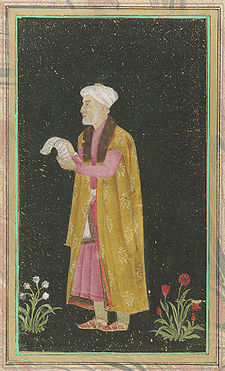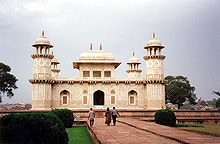- Mirza Ghiyas Beg
-
Mirza Ghiyas Beg (Persian: مرزا غياث بيگ) was an important official in the Mughal empire, whose children served as wives, mothers, and generals of the Mughal emperors.
Biography
Ghiyās Beg immigrated to India from Persia after the death of his father and his family's fall from grace. He was received by the Emperor Akbar, and quickly climbed his way through the intricate Mughal court, serving as a court official under Akbar and his son, Jahangir. Akbar conferred the title of I'timād-ud-Daulah (pillar of the state) on him.
He was an important official the rule of the Mughal Emperor Jahangir, and served as the Diwan of the Empire, the chief treasurer, and he was given the title 'I'timād-ud-Daulah' (Persian: اعتماد الدوله), which means 'Pillar of the State'. His daughter, Mehrunissa (Nūr Jahān) married Jahāngīr in 1611, and his son Abdul Hasan Asaf Khan served as a general to Jahangir.
He was also the grandfather of Mumtaz Mahal (originally named Arjumand Bano, daughter of Abdul Hasan Asaf Khan), the wife of the emperor Shah Jahan, responsible for the building of the Taj Mahal. Jahangir was succeeded by his son Shah Jahan, and Abdul Hasan served as one of Shah Jahan's closest advisors. Shah Jahan married Abdul Hasan's daughter Arjumand Banu Begum, Mumtāz Mahal, who was the mother of his four sons, including his successor Aurangzeb. Shah Jahan built the Taj Mahal to serve as Mumtaz Mahal's tomb.
Ghiyas Beg died shortly before Jahangir's death in 1627. Nur Jahan commissioned the construction of I'timād-ud-Daulah's Tomb in Agra, which is as an architectural predecessor of the Taj Mahal.
References
- Keay, John (2000). India: A History. Grove Press, New York.
Categories:- Mughal nobility
- People from Agra
- 1627 deaths
Wikimedia Foundation. 2010.


